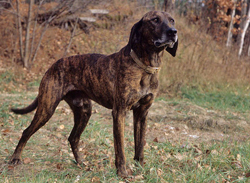Plotts have lean, muscular frames and smooth, glossy coats that come in solid black, all shades of brindle, or with other markings. Some dogs are double coated and have a short and soft undercoat and a smooth and long outer coat. The breed's eyes are hazel or brown, the ears are medium length and low hanging, and these dogs have square muzzles. Plotts measure 20 to 25 inches tall at the shoulder and weigh 40 to 60 pounds.
Plotts are intelligent, bold, loyal, and eager to please. Inside the home, these dogs tend to be friendly and gentle. They get along well with children and love spending time with their human family.
A loyal, intelligent, and eager to please breed, Plotts make good family companions. These dogs are friendly in the home, while remaining bold, aggressive, and fearless when hunting. Plotts need daily exercise and are very vocal, but they are low-maintenance pets when it comes to grooming.
Plotts are one of America's few homegrown dogs and hail from the mountains in the western part of North Carolina.
Plotts are intelligent, bold, loyal, and eager to please. Inside the home, these dogs tend to be friendly and gentle. They get along well with children and love spending time with their human family. Outside the home, Plotts are determined, alert, and even aggressive. They are fearless and focused hunters.
Ideally, Plotts should live in single-family homes with large, fenced yards. They need space to run and play, and they likely won't get enough exercise in a small apartment. Regular walks on a leash are also beneficial. These dogs enjoy hiking and hunting.
Plotts do well with most other pets, including cats, provided they are raised together. If these dogs have limited experience with other animals, the urge to hunt and chase cats and rodents may be too strong to resist. Always supervise these dogs when they are around children and small animals.
Plotts are generally healthy dogs and are not known to suffer from an excess of serious health problems or genetic diseases. Of course, this is no guarantee that any individual dog will be healthy and free of illness. Purchasing or adopting this breed from a reputable source goes a long way toward ensuring a healthy dog.
Due to their deep chests, Plotts are more prone to bloat and gastric torsion than some other breeds. This condition is potentially fatal, but the risk can be minimized by feeding smaller portions throughout the day. Additionally, Plotts are at increased risk for hip dysplasia and ear infections.
With routine veterinary care, regular exercise, and a proper diet, Plotts typically live a full and active life of up to 14 years.
Plotts, like other hounds, are independent thinkers that tend to be stubborn and prefer to get their own way. This can make training difficult, but it certainly doesn't mean training is impossible. For best results, training should begin as early in life as possible and should always be done by an experienced dog owner or professional trainer.
Patience and positive reinforcement are key when training these independent and stubborn dogs. Training must also be consistent; irregular training sessions and unclear commands will result in regression and loss of attention. These dogs learn best through repetition.
The breed's tendency to be noisy may annoy neighbors. Keeping these dogs busy, exercised, and entertained can help. Plotts are natural explorers and diggers, which often leads to trouble. These escape artists should be contained in a securely fenced yard to keep them from jumping or digging out and putting themselves in harm‘s way.
A low-maintenance breed, Plotts require minimal coat care. A weekly brushing with a rubber curry brush will keep the coat clean, tangle-free, and shiny. These dogs shed, however, and more frequent brushing may be necessary during spring and fall shedding seasons to keep hair from accumulating along baseboards and on furniture.
Like other scenthounds, Plotts have a musty odor that is offensive to some people. Regular baths with a gentle, pH-balanced canine shampoo will help keep odor under control, but there's no way to completely eliminate the breed's scent. When not bathing these dogs to remove odor, baths are only necessary if the breed rolls around in something sticky or harmful.
The Plott's nails need clipping every couple of weeks, and their teeth should be brushed daily to prevent tartar accumulation, tooth decay, and gum disease. Additionally, the ears should be checked at least once weekly for excess ear wax and signs of infection, which may include discharge, odor, redness, and pain.
Plott's are one of few dog breeds native to the United States. In 1750, two brothers immigrated to America from Germany, bringing with them five Hanoverian Hounds. One of the brothers settled in North Carolina and bred his dogs, mixing them with North American Curs, to hunt boar and bear. The resulting dogs became known as Plotts, named after the family that created them.
Plotts grew in popularity as coonhounds and the breed eventually spread out of the Carolinas. They were prized hunters, but they were also effective home guardians and were sometimes used to drive livestock. Plotts are the only coonhounds that do not descend from Foxhounds.
These days, Plotts can be found working in a variety of jobs. Some track cougars for tagging by wildlife agencies, others work in search and rescue, and still others are used as hunting dogs. The breed can also be found in the show ring. The Plott has been North Carolina's official state dog since 1989.
The American Kennel Club officially recognized the Plott in 2006.

